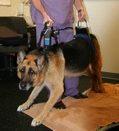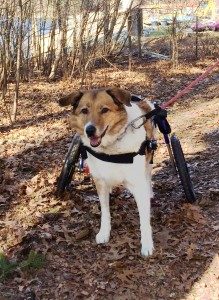Supportive Slings, Braces, Assistive Devices
Supportive Slings and Harnesses
We use a variety of supportive slings and harnesses to provide a dog with support in standing and walking. Slings can be used to support non  ambulatory patients, patients with weakness or paralysis of the hindlimbs or to aid in walking with post orthopedic surgery patients.
ambulatory patients, patients with weakness or paralysis of the hindlimbs or to aid in walking with post orthopedic surgery patients.
Walking with the aid of a sling will protect the patient, allow them some mobility, and in the case of neurologically challenged patients, the psychological boost of being in an upright, standing position for the first time in days. Standing with the aid of a harness provides important sensory feedback, while walking helps to promote the development of muscle mass if it has been lost due to disuse or neurological wasting. Standing can also help to decrease or prevent congestion of the lungs for patients who would otherwise be lying down for long periods of time.
For post neurological surgery pets or for pets with neurological symptoms we recommend a harness or sling that will provide support of the pelvic region as apposed to a belly sling. The pelvic support prevents hyperflexion of the spinal cord which can irritate or damage surgical, or painful sites.
Supportive slings come in a range of sizes and harness types. Please call the Sports Medicine and Rehabilitation department if you have questions about your pet and his or her specific needs.
Veterinary Orthotics and Prosthetics (VOP), braces, assistive devices
- Veterinary Orthotics and Prosthetics (VOP)
- Custom-fabricated Braces
- Custom-fabricated Prosthetics
- Wraps and other supportive devices
- Wheelchair measuring and fitting for neurologic pets who have not regained the ability to walk
- Harness fittings
Common Injuries That May Benefit from an Assistive Device, Orthotic Brace or Prosthetic:
| The Elbow | |
| Medial compartment arthritis | Triceps tendon avulsion |
| Varus/Valgus instability | Hygroma |
| Medial compartment unloading | Degenerative joint disease |
| Medial & lateral collateral ligaments | Post-op arthrodesis |
| Carpus (wrist) and Paw | |
| Hyper-extension instability | Failed arthrodesis |
| Flexor carpi ulnaris | Digital flexor(s) |
| Medial and lateral collateral | Neurological positioning control |
| Osteosarcoma palliative care | Brachial plexus |
| Post-Op pancarpal arthrodesis | Radial nerve |
| Post-Op partial carpal arthrodesis | Digit amputation or malformation |
| Chondrodysplastic triplanar instability |
| Stifle (Knee) | |
| Cranial cruciate ligament | Tibial crest fracture |
| Caudal cruciate ligament | Luxating patella |
| Medial and lateral collateral ligament | Pivot shift instability |
| Patellar tendon |
| Tarsus (Hock) and Paw | |
| Achilles complex | Digital flexor(s) injury |
| Post-op arthodesis | Hyper-extension instability |
| Medial and lateral collateral injury | Neurological positioning control |
| Immobilize tibiotarsal joint |
| Pelvic (Hind Limb) Prosthetics | |
| Elective subtotal amputation | Congenital deformity |
| Amelia | Residual limb protection |
| Thoracic (Forelimb) Prosthetics | |
| Elective subtotal amputation | Congenital deformity |
| Amelia | Residual limb protection |